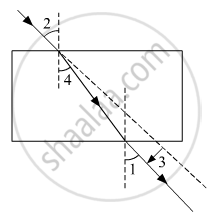Advertisements
Advertisements
Question
A student claims that because of atmospheric refraction, the sun can be seen after it has set, and the day is, therefore, longer than if the earth had no atmosphere.
What does the student mean by saying that the sun can be seen after it has set?
Solution
The refraction of sunlight by the earth's atmosphere causes the sun to be seen for about two minutes even after it has set below the horizon.
APPEARS IN
RELATED QUESTIONS
The correct sequencing of angle of incidence, angle of emergence, angle of refraction and lateral displacement shown in the following diagram by digits 1, 2, 3 and 4 is:

(a) 2, 4, 1, 3
(b) 2, 1, 4, 3
(c) 1, 2, 4, 3
(d) 2, 1, 3, 4
Atmospheric refraction causes advance sunrise and delayed sunset. By how much time is:
sunrise advanced?
Atmospheric refraction causes advance sunrise and delayed sunset. By how much time is:
sunset delayed?
Why do stars seem higher than they actually are? Illustrate your answer with the help of a diagram.
The twinkling of stars is due to atmospheric:
(a) reflection of light
(b) dispersion of light
(c) interference of light
(d) refraction of light
The atmospheric refraction of light causes the twinkling of:
(a) planets only
(b) stars only
(c) planets and stars
(d) stars and satellites
A student claims that because of atmospheric refraction, the sun can be seen after it has set, and the day is, therefore, longer than if the earth had no atmosphere.
Do you think that the students conclusion is correct?
Why does the sky appear blue on a clear day?
The stars appear higher from horizon than they actually are. Explain why it is so.
Assertion: Sky appears blue in the day time.
Reason: White light is composed of seven colours.
